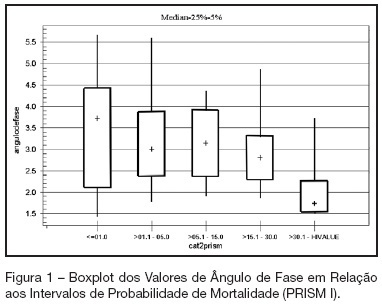Abstract
Rev Bras Ter Intensiva. 2007;19(3):297-303
DOI 10.1590/S0103-507X2007000300005
BACKGROUND AND OBJECTIVES: Phase angle (PA) is the difference between voltage and current and can be used as an indicator of body cell mass. Clinical studies show that low phase angle is associated with morbidity and mortality of critical patients. The purpose of this study was to know the relation between phase angle and the Pediatric Risk of Mortality I (PRISM I) score, associating this score with the severity of sepsis. METHODS: A transversal study was performed at the Pediatric Intensive Care Unit (PICU) in Instituto Fernandes Figueira. The patients were classified according to age, gender, sepsis severity, cause of respiratory failure, PRISM I score, multiple organ dysfunction syndromes (MODS). Electrical bioimpedance analysis (BIA) was performed in all patients. Phase angle was calculated directly from reactance (Xc) and resistance (R). AF = arc-tangent reactance/resistance x 180º/Pi. RESULTS: 75 patients (68 septic) were evaluated. The incidence of septic shock was 39.7%, severe sepsis 42.6% and sepsis 17.6%. There was no significative statistical difference between the mean values of BIA and the categories of PRISM I, MODS, or the length of stay the PICU. The PA's lowest values (1.5º-2.2º) were associated to the greatest PRISM's scores (> 30%). CONCLUSIONS: Pediatric critical patients show low phase angle values, which might have prognostic implication.
